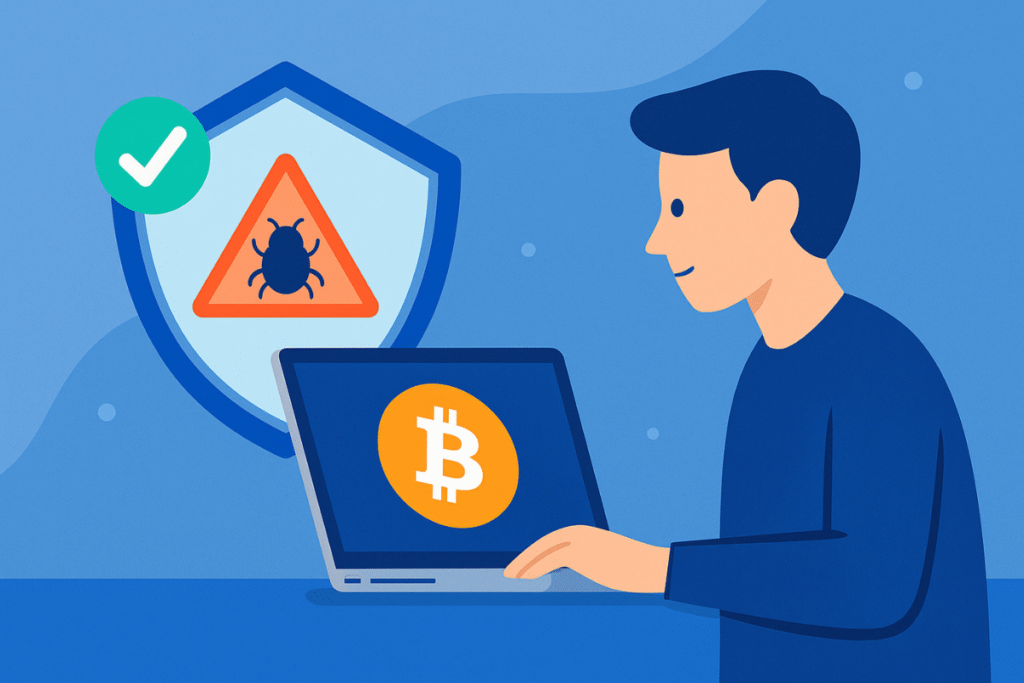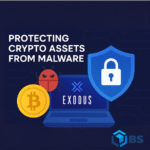Now Reading: Exodus Wallet Malware Attack 2025: What Really Happened & Why It Matters
-
01
Exodus Wallet Malware Attack 2025: What Really Happened & Why It Matters
Exodus Wallet Malware Attack 2025: What Really Happened & Why It Matters

Exodus Wallet Hack 2025 has shaken crypto users worldwide, with many reporting unauthorised transactions and vanished funds. While Exodus has long been trusted as a non-custodial wallet known for its sleek interface and asset diversity, this latest incident has raised major concerns about user safety.
In this guide, we’ll break down what really happened during the Exodus Wallet malware breach, analyse real user reports and official statements, and show you exactly how to protect your digital assets in 2025 and beyond.
Key Takeaways:
- Exodus itself was not breached, but users were targeted via malware
- Protecting your seed phrase and device is non-negotiable
- Hardware wallets offer enhanced protection for serious investors
- Regular education and vigilance are the only way to stay ahead of attackers
As crypto adoption grows, so do the threats. Use this case as a wake-up call and take your crypto security to the next level.
Exodus Wallet Hack 2025: How the Hack Unfolded

In early 2025, Reddit, HackerOne, and other online forums were flooded with alarming posts about the Exodus Wallet malware attack. Users reported that their Exodus desktop wallets had been emptied overnight, even though they hadn’t shared their seed phrases or passwords.
As patterns emerged, it became clear that this wasn’t a traditional hack of the Exodus platform itself—but rather a targeted malware campaign infecting users’ devices and compromising their crypto wallets.
Timeline of the 2025 Exodus Wallet Malware Attack
- 🚨 Early 2025: Exodus users report missing funds and suspicious wallet activity
- 🔍 Investigations reveal malware—not a platform breach—is to blame
- 🛡️ Exodus confirms no server-side compromise; private keys remained secure on local devices
- 🧬 Security experts identify “npm malware,” used to target Exodus and Atomic wallet users
- 🧠 Attack methods included keyloggers and clipboard hijackers to steal credentials
This wasn’t a direct hack of the Exodus platform itself but rather a targeted attack on users’ devices, often via phishing emails, rogue downloads, or compromised browser extensions.
Exodus’ Official Response to the 2025 Wallet Malware Incident
Following the Exodus Wallet Malware Attack 2025, Exodus took swift action to reassure users and investigate the claims. According to Exodus’ official support article, their response included:
- 🔍 Opening case-by-case investigations with affected users
- 🛑 Urging users to run full malware and antivirus scans
- 🔐 Advising immediate migration to new wallets with fresh recovery phrases
- 🔒 Confirming no breach on Exodus servers — all private keys remained local and encrypted
This proves the breach wasn’t due to a failure of the Exodus platform, but rather user-side malware infections, similar to those described in this crypto malware analysis by CISA.
👉 “To explore more scam threats like this, see our full list of Fake Crypto Exchanges to Avoid in 2025.”
Why Did the Exodus Wallet Malware Attack 2025 Succeed? Understanding Device-Level Risks
The Exodus Wallet Malware Attack 2025 wasn’t a flaw in Exodus itself it was a wake-up call about the risks of using non-custodial wallets on unsecured devices. Non-custodial wallets like Exodus are designed to empower users by storing private keys locally. But this also means that if your device is compromised, so is your crypto.
Here’s how attackers got in:
- 🧬 Malware installers disguised as wallet updates or free apps
- 🖱️ Clipboard hijackers that silently change copied wallet addresses
- 📧 Phishing emails tricking users into downloading infected files
- 🔑 Keyloggers capturing login info, passwords, and seed phrases
Even if Exodus remains secure, your operating system and browsing habits can open the door to attackers.
Read more on our guide: How to Tell If Someone Is a Crypto Scammer: 8 Red Flags
Protecting Yourself After the Exodus Wallet Malware Attack 2025: 5 Must-Do Steps

If you’re using Exodus or any desktop crypto wallet here’s how to stay safe:
Worried after the Exodus Wallet Malware Attack 2025? You’re not alone but you can still act. Here’s how to make sure your wallet (and crypto) stays safe going forward:
- Avoid Suspicious Links and Downloads
Only download Exodus from its official site. Ignore pop-ups, email links, or “update” messages unless they’re verified. - Scan Your Device Immediately
Use trusted tools like Malwarebytes, Bitdefender, or Windows Defender to remove malware or keyloggers. - Never Store Your Seed Phrase Digitally
Avoid keeping your recovery phrase in screenshots, notes apps, or cloud storage. Write it down and store it offline in a safe location. - Switch to a Hardware Wallet for Large Holdings
Protect major assets using cold wallets like Ledger or Trezor, which keep your keys completely offline. - Keep All Software Updated
Ensure your wallet app, antivirus, and OS are always running the latest version to avoid known vulnerabilities.
🔐 Bonus Tip:
Want more tips on securing your crypto journey? Check out: How to Spot a Crypto Scammer in 2025
What to Do If You Were Affected by the Exodus Wallet Malware Attack 2025
If you suspect your funds were compromised in the Exodus Wallet Malware Attack 2025, quick action is key. Here’s what to do next:
- Move Funds Immediately
Transfer any remaining crypto to a new wallet — ideally on a clean, malware-free device.
🔗 Internal tip: See our full list of legit crypto wallets to avoid scams - Contact Exodus Support
Reach out to Exodus Support and report your transaction ID, timing of the hack, and any suspicious behaviour. - Scan and Secure Your Device
Perform a deep malware scan. If needed, reinstall your OS to eliminate hidden backdoors. - Report the Incident
Alert your local cybercrime authorities (e.g. FBI Internet Crime Complaint Center in the US or Action Fraud in the UK). - Warn the Community
Post your experience on platforms like Reddit’s r/CryptoCurrency or r/ExodusWallet to help others stay safe.
📌 Reminder: Exodus doesn’t store your keys — it’s your device that got infected. Fixing the root issue is essential.
You can also check this detailed guide by Exodus on the exact steps to take if unauthorized transactions are spotted.
Exodus Wallet Malware Attack 2025: What Real Users Are Saying

The Exodus Wallet Malware Attack 2025 has triggered heated debates across Reddit and other crypto forums. Some users are demanding better in-app protections, while others admit the attack highlights poor personal security hygiene.
Here’s what the crypto community is saying:
- “We need 2FA as a standard. It’s 2025, not 2015.”
- “Exodus should flag logins from new devices.”
- “Device hygiene is key treat your wallet like your bank.”
While Exodus responded by reaffirming that no server breach occurred, they also reminded users that private keys are stored locally — meaning any compromise is due to malware on the user’s end.
💬 On forums like r/CryptoCurrency, many users recommended moving large funds to hardware wallets like Ledger or Trezor for long-term security.
Should You Trust Exodus After the 2025 Malware Attack?
In the aftermath of the Exodus Wallet Malware Attack 2025, many users are left wondering: is Exodus still safe to use?
While Exodus itself was not directly breached, the attack revealed major weaknesses in user-side security. That said, Exodus remains one of the most popular non-custodial wallets with millions of downloads and an intuitive interface.
Why users still trust Exodus:
- Simple UI, ideal for beginners
- Supports 300+ cryptocurrencies
- Built-in exchange and staking features
- No sign-up or KYC needed for wallet use
Limitations after the malware incident:
- No built-in two-factor authentication (2FA)
- Highly dependent on user’s device security
- No way to recover stolen funds once compromised
🔒 If you’re serious about long-term crypto storage, consider a hardware wallet such as Ledger Nano X or Trezor Model T. For short-term use or smaller amounts, Exodus still provides an excellent user experience as long as your device is clean.
💡 Read our full guide on non-custodial vs custodial wallets to choose the best option for your crypto safety.
Conclusion: What the Exodus Wallet Malware Attack 2025 Taught Us
The Exodus Wallet Malware Attack 2025 serves as a crucial reminder that in the world of crypto, your security begins at home.
This wasn’t a flaw in Exodus’s infrastructure—it was a widespread user-side vulnerability exploited through malware. In a decentralised world, you are your own vault, firewall, and IT department.
To stay protected:
- Don’t store recovery phrases digitally
- Keep your devices malware-free
- Use hardware wallets for large holdings
- Only download apps from trusted sources
As crypto becomes more mainstream, so do the tactics used by attackers. Whether you use Exodus or another wallet, the responsibility of protecting your assets ultimately rests with you.
🧠 Want to dive deeper? Explore our latest article on common crypto scams to avoid in 2025.




























Pingback: How to Use AI to Extract Text from Images (Free & Easy Tools)
Pingback: How to Start Freelancing in 2025? Step by Step Guide
Pingback: Crypto Market Update May 2025: Prices, Trends & Big Shifts
Pingback: 🚨 Scam Alert 2025: List of Fake Crypto Exchanges You Must Avoid (Shocking List)
Pingback: 7 Warning Signs: How to Identify Fake Cryptocurrency & Scam
Pingback: China Crypto Ban 2025 – Full Impact & Global Reaction